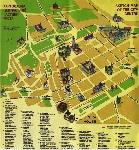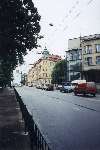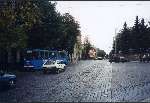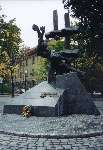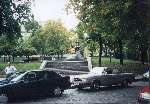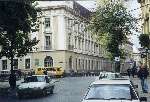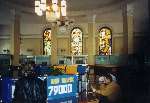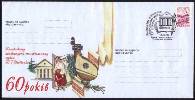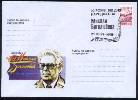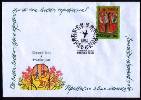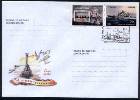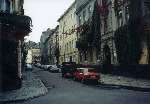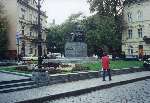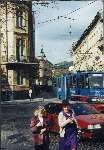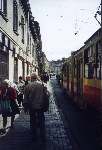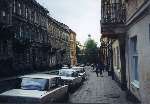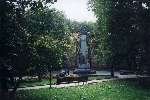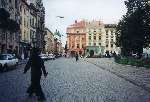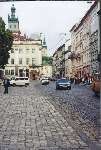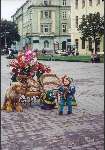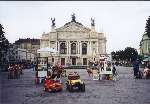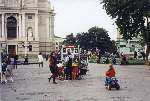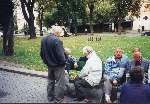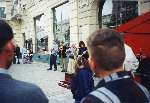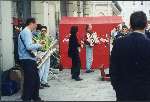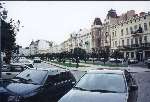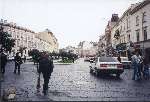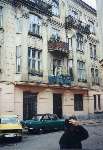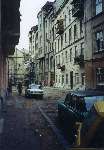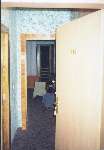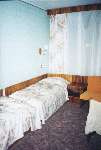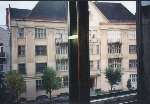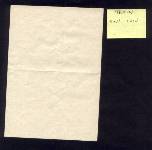|
Introduction |
TRIP TO UKRAINE
|
||
|
Tuesday, September 28, 1999 |
|||
|
Dad had an appointment to spend the day with a professor friend from the University. I joined them for an early lunch, then we separated, I to spend the rest of the day wandering on my own - I was glad of some time alone, and the opportunity to go wherever I chose, and photograph at leisure anything that looked interesting. Unfortunately, I've no idea what a lot of it is!
If you can add a name to anything pictured here, email the author: |
|||
|
Street scenes in the area just South of our hotel. I saw very few fountains in either Kyiv or L'viv. Both cities are built on rivers (the one in L'viv has been covered over now, and runs under the central avenue), so there's no shortage of water. I guess it's just not the local style. The third and fourth images show a very dramatic monument, perhaps in memory of the casualties of the Great Famine? It has the modern Ukrainian emblem, so must date from the period since Independence. |
|||
|
I used to be a stamp collector, so I had to check out the main Post Office. It was just a short walk away, at vul. Slovats'koho 1, a few blocks east of our hotel. In the style of all Post Offices there, it houses Telegraph, Telephone, and Banking facilities as well. The last photo shows the Foreign Exchange hall, upstairs. Apparently people in Ukraine do not customarily buy stamps to have on hand, as all the clerks I dealt with seemed surprised when I asked to do that. Everyone else I saw presented a piece of mail and paid to have it stamped and placed in the mail. Nor did I see many mail boxes on the streets. Not surprising, I suppose, considering that it cost about 80 cents to mail a postcard to the USA - I figure that's nearly half a day's wages for Orest. Once the postal clerk I was talking to understood that I was a collector, she pulled out a binder and showed me some official First Day Covers and special cancels. I bought a few of each.
In the States, First Day Covers are not sold in Post Offices, though basic ones are available from the USPS mail order division. The US may be the only country that still has a thriving independent FDC industry, precisely because the postal service has not taken over the territory. Nor are coordinated envelopes like these available for pictorial cancels, except from private producers. |
|||
| Another courtyard. |
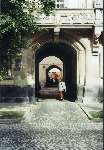
|
||
|
Cupola, the restaurant where we had lunch on both our first and last days in L'viv. |
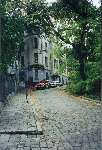
|
||
| Early afternoon street scene. |
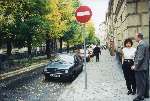
|
||
|
The city is very neat and clean, and could be quite beautiful if spruced up a bit. There are many attractive and interesting statues and monuments, and there were still many flowers in bloom. This part of the city (surrounding the oldest part) is mostly 19th century. |
|||
|
Shevchenko Place, from the South - this is the street where all the (relatively) chic stores seemed to be. I saw very few stores selling anything other than necessities, though. The people who live there cannot afford luxuries, and there are not enough tourists yet to support them. |
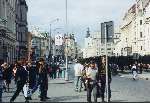
|
||
|
I was apprehensive about using this men's room underground (Dad and I visited one in Kyiv that was pretty scary, even with the two of us), but it turned out to be clean and well- lighted, with an old woman in a small booth as attendant at the bottom of the stairs. I paid her about 10 cents, for which she insisted on showing me how everything worked. Then she returned to her booth. |

|
||
|
Because it was under Austrian rule from 1772 to 1918 and dominated culturally and politically by Poles and then part of interwar Poland until 1939, L'viv looks more like those Western countries, whereas Kyiv, which has been under Russian control much longer, looks more Eastern. Scenes like this reminded me of Budapest when I was there in 1972. |
|||
|
There are many small parks and plazas with monuments. My ignorance of the language made being on my own difficult, in that I could not read the plaques and signs to find out what I was looking at. Nor had I been able to find a guidebook in English. Moreover, we are taught so little history of this area in our schools, that I would not have known the significance of the events and people commemorated, even had I been able to read. Many of the honorees turned out to be Polish or Hungarian, put here by the former rulers to honor their culture. Awareness of Ukrainian culture and achievements, such as the homage to Shevchenko and Franko is fairly recent. |
|||
|
Looking West towards the oldest part of L'viv - the round tower at the end of the street is the Gunpowder Tower (1556). This was just outside the walls of the medieval city. |
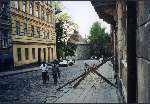
|
||
| A charming balcony. |
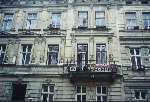
|
||
| Woman walking her dog. |
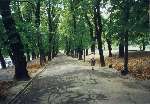
|
||
| Entrance to Gunpowder Tower - obligatory lions. |
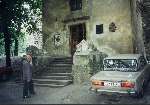
|
||
|
Dominican Church, in top right corner. Statue of I. Fedorov at center (in 1574 he published the first book in Ukrainian). Royal Arsenal building on the right. |

|
||
|
Late 19th century office building in eclectic style, with Ukrainian decorative motifs. |

|
||
| Billboard to advertise renovation project in Old Town. |

|
||
|
Scenes around the central square and Town Hall of Old Town. Many buildings here date from 16th century, when the last of the great fires destroyed everything wooden, and laws were passed that required all construction to be in stone (RYNOK SQUARE). |
|||
|
Looking Southwest from the corner of Rynok Square, the Latin Metropolitan Cathedral (begun in 1360), on Cathedral Square. |
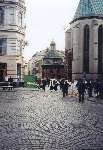
|
||
|
Note how few ads, signs, lights there are - I presume some of that is planned, to preserve historic sites, and some is a legacy of Communism, and some is the backward economy. I found it all very quaint and charming, until I realized the people there would love to have billboards and McDonalds and Burger King everywhere. |
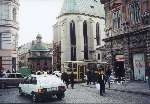
|
||
| Another courtyard. |

|
||
|
At the top of the Town Hall, the Greater Seal of L'viv, flanked by Lev, and his namesake. |
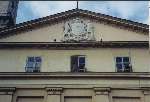
|
||
|
And another courtyard - perhaps I will do a book of views like these, some day. |
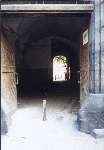
|
||
| Looking towards Freedom Prospect, near the Opera House. |
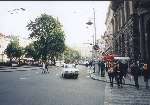
|
||
|
Also near the Opera House - the large building on the far corner is a department store, presumably State-owned. We went in looking for postcards, and couldn't find any. What struck me most about it was how chaotic it seemed, and how lacking in a sense of unity. It seemed more like a bazaar, a collection of independent vendor stalls, than a unified store. |
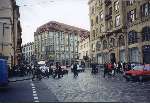
|
||
|
Looking North from behind the Opera House. |

|
||
| Looking West from behind the Opera House. |
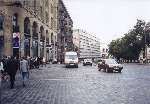
|
||
|
Opera House program for October.
Sunday night, after our return from Zvenyhorod, we had attended a performance of Madam Butterfly (in Ukrainian). Front row center seats for $5 each! I was surprised how well it was performed, especially once I saw the very ambitious program the company puts on four or five nights a week - Traviata, Trovatore, Carmen, Coppelia, Pagliacci, Tosca, Giselle, Rigoletto, Aida, etc. I left my camera at the hotel that night for some reason, and regretted it, as the Opera House was spectacular inside. |
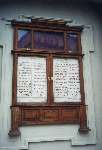
|
||
| Opera and Ballet program for September. |
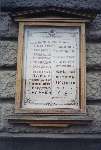
|
||
|
Freedom Prospect, in front of the Opera House, always busy. It used to be Lenin Prospect, of course. |

|
||
|
I saw few people patronizing them, but the photo stand and rides for the kiddies were cute and colorful, and stood out for being very out of the ordinary here. |
|||
|
The WEATHER was excellent our entire trip. It was warm for late September, and there was little rain. Apparently we could have had even snow! I found it perfect for playing tourist. |
|||
|
There were many sidewalk cafes. I would have tried a few, but had been warned to be careful what I ate or drank, so took meals only at the hotel, or with family, and came out ok. |

|
||
|
There were twenty or thirty games of chess under way on the benches of Freedom Prospect. People were suspicious of cameras, and looked unhappy to be photographed. I guess old habits die hard. |
|||
|
The local equivalent of Hyde Park Corner in London - lively debates are always in progress. There was a major national election just a few weeks off, and everyone we talked to lamented the poor candidates - former KGB officials, crooks and dreamers. TV cameras were on site this day. And could that be a jogger? The only one I saw. |

|
||
|
Looking across Freedom Prospect - tower of the Latin Metropolitan Cathedral in background. |

|
||
|
The Grand Hotel - L'viv's finest (foreign-owned, of course). Dad and I had an excellent dinner here one night, and had the dining room to ourselves. |
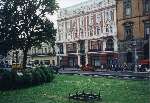
|
||
|
Only the brave drive in Ukraine! Our car cost $30 a day in town, $50 when we drove out to the villages (including car, gas, and driver). We worked our driver hard, but that's an excellent wage there. In fact, Dad was cautioned not to pay more. I felt very safe with Ivan, and often wondered how he did it. The roads are in generally poor condition, and poorly marked. |
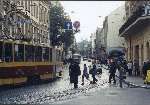
|
||
| Future table tennis champions practicing. |
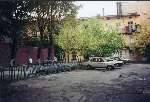
|
||
| Return to Freedom Prospect. |
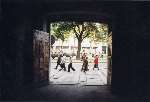
|
||
| No takers for personal sittings, so he draws famous people. |
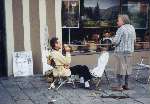
|
||
|
Behind the Hotel George was this band playing a Ukrainian variety of Dixieland Jazz. They attracted a small crowd, but most people hurried by. Note again the clothes - no tee shirts or shorts (temperature was about 80, mid- afternoon, humid). Many men wear shirts and sports jackets. |
|||
|
As I was walking away, a troop of soldiers marched by. They were everywhere - it reminded me of Spain in 1962. In both cases, I did not feel threatened, the army seemed mostly a way for the government to provide work for the young and restless, but at times I felt a hint of discomfort, and the sense that the soldiers also keep people from expressing their discontent more openly. |
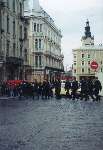
|
||
|
Shevchenko Place from the other end. This area was given a facelift for a recent "Summit" meeting of European government leaders, held in L'viv. |
|||
| Balconies, courtyards. | |||
|
I find Ukrainian a difficult language, for several reasons - First, the alphabet, of course. I learned it many years ago, but never used it enough to read it easily. Second, Slavic languages share far fewer roots with English than do the Western European languages, so one simply has to memorize everything. Third, the grammar is complex, with genders, declensions, and irregularities, so one sounds foolish easily. Finally, I studied some Russian, so the words most likely to come out of my mouth are in that language - NOT a popular one in Western Ukraine. |
|||
|
There were street vendors everywhere, many selling routine items like soap and toothpaste, or whatever garden produce they could carry. This one had small children's toys, items one would expect to see in permanent shops. |
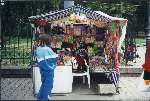
|
||
| Outdoor café and bar - there were many bars. |
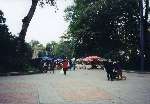
|
||
| Queuing for buses outside the University - there were queues here all day long. |

|
||
|
Symbolic statue group on top of the Ivan Franko State University of L'viv. I think the woman symbolizes the River Dnister. Yes, there used to be a hammer and sickle where the Ukrainian trident is now. |
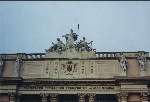
|
||
| Ivan Franko, famous Ukrainian poet and nationalist. |
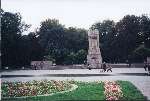
|
||
|
These were the only bicycles I saw being used for fun (in Ivan Franko Park) - no skateboards or inline skates anywhere. I did see a few skaters in Budapest. |

|
||
|
The little boy in red was fascinated by the music - a keyboard player was warming up under the red awning. Daddy wanted to leave, but the little boy refused, and started dancing. |
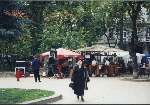
|
||
|
Ivan Franko Park lies between our Hotel (The Dnister) and the University. This park is one of the oldest in L'viv. In the XVI century it belonged to the Church and consisted of many gardens which were used by the Jesuits to grow vegetables. By 1773 it became known as Jesuit Park. Many trees were planted in the years 1855-1890. Presently there are over 50 different kinds of trees and bushes in the park. In the 1930's the park was called Tadeusz Kosciushko Park. After World War II the park was renamed Ivan Franko Park. The statue of Ivan Franko that stands opposite the University was completed in 1964 according to the plan of sculptor Emanuel Misko. |
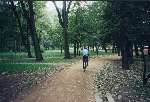
|
||
| Home - the Hotel Dnister. |
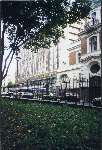
|
||
| Statue of Mercury tops a building near the hotel. |

|
||
|
My room at the hotel. The accommodations were adequate, but a bit shabby. The public areas and luxury rooms at the hotel had been refurbished for the May Summit, but the standard rooms could use renovation. The tile-work in the bathroom was poorly executed - I suspect they don't use it enough to know how to do it properly. Water was fairly reliable, but I lost the COLD water during a shower one morning - fortunately, the hot was not very hot. The TV had cable, with about 20 stations, most in Ukrainian or Russian, a couple in German, and the only one in English broadcast nothing but European off-road vehicle trials, dog shows and horse shows. There was an MTV-style music channel with really obnoxious advertising. One station had lots of foreign soaps and sitcoms, overdubbed in Ukrainian, but all the same (male) voice. |
|||
|
Views from the window. There was a very pleasant street of older apartments behind the hotel - the neighborhood was very quiet until 8 AM - apparently they start later there. I could see the dome of St. George's Church by leaning out the window of my hotel room and looking to the side. Dad was on this side of the building, too. We didn't get to see a room on the other side, but they must have wonderful views of the park and old city center. |
|||
|
TOILET PAPER IN UKRAINE Everyone who travels to Europe, especially eastern Europe, complains about the toilet paper. Those with sensitive derrieres take their own. So here's my report. I brought back samples. I won't say the situation has been exaggerated, but things weren't as bad as I had expected (I did not take my own). I traveled in western Europe in 1963, and back then it WAS true, the toilet paper in public restrooms - on trains, in youth hostels, in pension hotels - was awful. It was stiff, non-absorbent, rough as sandpaper - like the construction paper you used in kindergarten, or worse - when present at all. If you didn't have your own with you, you could be in trouble. Some places had old newspapers or magazines, which were an improvement over the official stuff, actually. Sample #1, from the Lybid Hotel in Kyiv. It was on a roll, and functioned as intended. Softness rating just so-so. Absorbency acceptable. Thc closest thing to it here in the States is crepe paper. Sample #2, from the train we took from Kyiv to L'viv. It was in sheets. Softness rating again so-so. Absorbency poor. Like low-grade note-paper. Other places I visited had grades in between these two. That public restroom in L'viv was better than average. SO, depending on how sensitive you really are, you might want to have your own TP handy. |
|||
Send feedback to the author: CLICK HERE
Created -- 03/22/2007 Revised -- 03/22/2007
